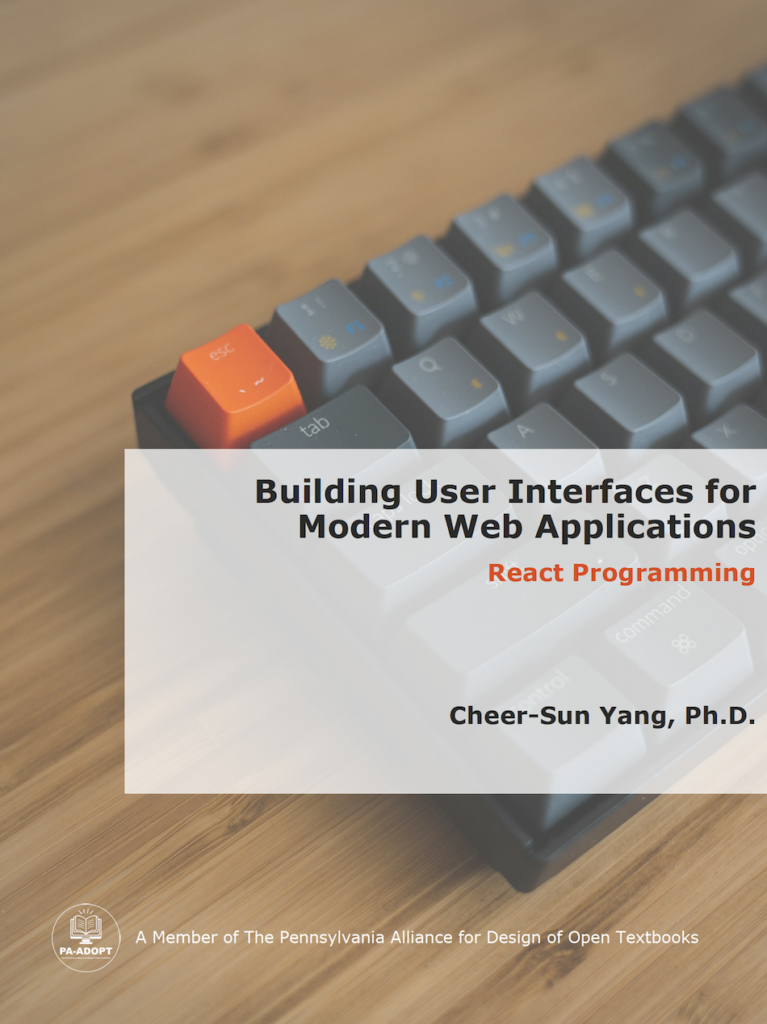Building User Interfaces for Modern Web Applications: React Programming
by Cheer-Sun Yang, Ph.D.
Keywords: Web Programming, Front-End User-Interface (UI) Technology, React Programming

About the Book
Since Facebook released React as an open-source software library for front-end programming in 2013, React has gain popularity quickly. Although there are other frameworks or libraries, React is considered a programmer-friendly JavaScript library using the functional programming approach for the front-end web application development. Teaching and learning React can provide training in Functional Programming, Software Engineering Principles, and the Event-Driven Programming Paradigm. The ultimate goal of this eTextbook is to provide a timely support for teaching the state-of-the-art technology as the React ecosystem evolves.
In this eTextbook, the prerequisite concepts about HTML/CSS, JavaScript, and Bootstrap/React-Bootstrap are introduced first, followed by the main React language features. Finally, the Software Engineering Principles are introduced from the design, development, to debugging and maintenance. The main objectives are threefold: (1) provide concepts about JavaScript Programming, (2) introduce the concepts of modularity, functional programming, and (3) teach the concept of reusable User Interface (UI) as the front-end of modern model-view-controller (MVC) web applications.
Although learning other technologies in the React ecosystem is imminent, it is the hope that this book paves the groundwork for the future learning and growing in the field of modern UI development.
Chapters
- Introduction and Set up
- HyperText Markup Language
- Cascading Style Sheets & Bootstrap
- JavaScript & JSX
- React Components
- Properties (Props)
- State
- Events
- Component Lifecycle & Reconciliation
- Conditional Rendering
- Lists
- Forms
- Lifting Up State
- Think in React
- React Routing
- Redux State Management
General Information
- Publication Year: 2024
- Edition: First
- Subject: Computers & Technology
- Latest File Update: December 2, 2025
License

This work is licensed under a Creative Commons Attribution-NonCommercial 4.0 International License (CC BY-NC 4.0) as a part of PA-ADOPT, except where otherwise noted.
Usage
Readers
The eTextbooks created as a part of this program are provided in two formats: ePub and PDF. Please refer to our Reader Support section for guidance on which format may be best for you and the device(s) you use.
Instructors
If you are an instructor seeking to use this eTextbook in your own course(s) please feel free to download the ePub and/or PDF file(s) for your use, but make sure to complete our eTextbook Usage Survey (this information is used for program evaluation purposes).
If you are interested in making revisions and edits to this eTextbook please note that this is possible since the book is under a Creative Commons License, which allows you to remix, reuse, revise, and redistribute the eTextbook. Please refer to the Faculty Support Page, specifically looking at Remixing. You can download Building User Interfaces for Modern Web Applications: React Programming Apple Pages File in order to use the original document to revise and remix the eTextbook for your purposes.
Citations
MLA: Yang, Cheer-Sun. Building User Interfaces for Modern Web Applications: React Programming. First, The Pennsylvania Alliance for Design of Open Textbooks (PA-ADOPT), 2024.
APA: Yang, C. (2024). Building User Interfaces for Modern Web Applications: React Programming. (First). The Pennsylvania Alliance for Design of Open Textbooks (PA-ADOPT).
Chicago: Yang, Cheer-Sun. Building User Interfaces for Modern Web Applications: React Programming. First. The Pennsylvania Alliance for Design of Open Textbooks (PA-ADOPT), 2024.
Peer Review
This eTextbook went through an Open Peer Review process. The peer review process used the Open SUNY Textbook Peer Review Guidelines, allowing peer reviewers to read the text carefully and evaluate the following:
- Educational Significance of Content including accuracy, appropriate and useful materials, valid and significant concepts, models, and skills, and key elements;
- Effectiveness as a Teaching Resource including a clear explanation of the concepts, alignment of materials to the learning process of the target audience, and alignment of the learning objectives with course goals; and
- Readability and Ease of Use including clarity and comprehensiveness, consistent writing style, readability and ease of use (logic, sequence, and flow), appropriateness for target readership level, and quality of Interactivity and multimedia learning objects.
As a part of the open peer review process, the public review conducted by Dr. Richard Burns is made available: Peer Review Document (PDF).